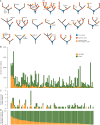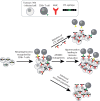Perspective: APOBEC mutagenesis in drug resistance and immune escape in HIV and cancer evolution
- PMID: 29324969
- PMCID: PMC5888943
- DOI: 10.1093/annonc/mdy003
Perspective: APOBEC mutagenesis in drug resistance and immune escape in HIV and cancer evolution
Abstract
The apolipoprotein B mRNA-editing enzyme, catalytic polypeptide-like (APOBEC) mutational signature has only recently been detected in a multitude of cancers through next-generation sequencing. In contrast, APOBEC has been a focus of virology research for over a decade. Many lessons learnt regarding APOBEC within virology are likely to be applicable to cancer. In this review, we explore the parallels between the role of APOBEC enzymes in HIV and cancer evolution. We discuss data supporting the role of APOBEC mutagenesis in creating HIV genome heterogeneity, drug resistance, and immune escape variants. We hypothesize similar functions of APOBEC will also hold true in cancer.
Figures





References
Publication types
MeSH terms
Substances
Grants and funding
LinkOut - more resources
Full Text Sources
Other Literature Sources

